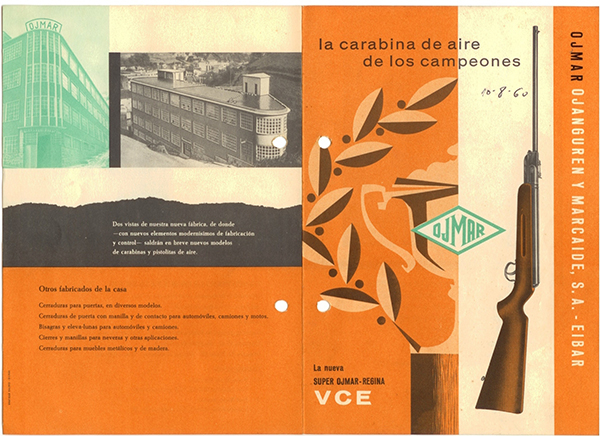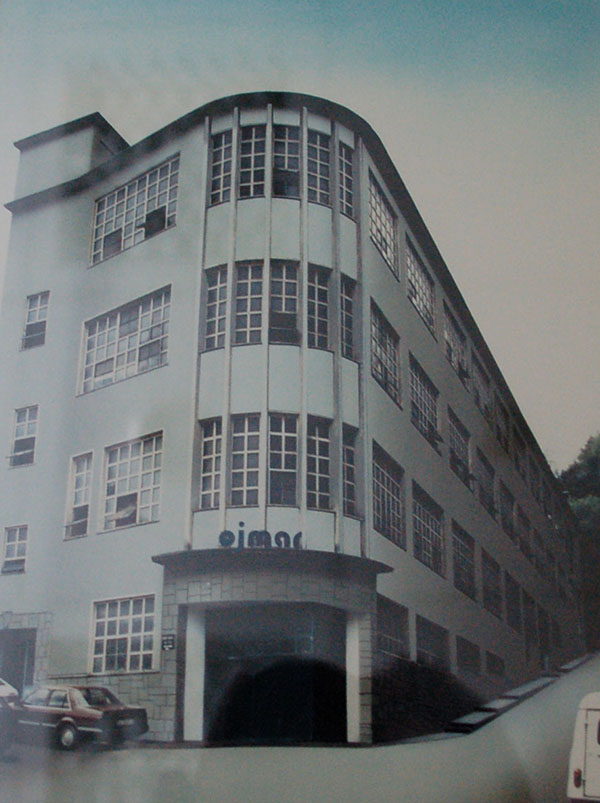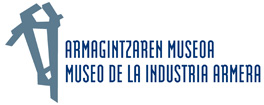
ARCHITECT: RamÃÂÃÂÃÂÃÂÃÂÃÂÃÂÃÂÃÂÃÂÃÂÃÂÃÂÃÂÃÂón de Martiarena 1957
The history of this industrial building, constructed at the request of the firm OJMAR (Ojanguren y Marcaide) in the neighbourhood known as Arane, reflects the essential history of Eibar and its arms industry.
The company dates back to 1917, the year in which Eibar arms producers reached record heights of production, benefiting from Spanish neutrality in the First World War. It was then that Francisco Ojanguren, a former employee of GÃÂÃÂÃÂárate, Anitua y C.ÃÂÃÂÃÂê (GAC), teamed up with Domingo and Basilio Marcaide to found OJMAR and produce ÃÂâÃÂÃÂÃÂÃÂBenemÃÂÃÂÃÂéritaÃÂâÃÂÃÂÃÂàautomatic pistols.

Like so many other workshops, they set up business in the very centre of Eibar, in the back yard of a block of flats in Dos de Mayo St (now Toribio Etxeberria), only yards from the main square and the town hall. There, in a simple wooden hut, they produced their revolvers, and continued to do so until 1939. In the following two decades they diversified production, branching out into the air rifle business. Growth of the company led to the need for more space, and in 1957 they moved to new premises in Arane St. designed by the architect RamÃÂÃÂÃÂón Martiarena. Here OJMAR switched production to the locksmith sector, and continues to supply these goods to this day, though from a plant outside Eibar.

In 1998 the building was taken over by Industrias Pampo, the spring manufacturer, and this provides a good example of how industrial buildings in Eibar were reused for purposes different from the original.

This factory building is one of the most unusual in the town, as its structure is perfectly adapted to the incline on which it is built. Martiarena came up with an audacious architectural solution, based on a four-level reinforced concrete structure with a majestic curved faÃÂÃÂÃÂçade at either end. The design, with great attention to detail, displays a surprisingly decorative style, most unusual for industrial buildings in the second half of the 20th century, particularly with regard to the choice of materials used, very different from the austerity we normally associate with factory buildings.
This artistic appearance is enhanced by the design of the windows in the two rounded chamfered corners: at the rear there are two large windows on each floor, adapted to the curve of the faÃÂÃÂÃÂçade, with the symmetrical axis coinciding with the point in the chamfer where the curve is most pronounced; on the front of the building, however, each floor only has one large window, with the centre coinciding with the deepest curve in the faÃÂÃÂÃÂçade. These windows are separated by six concrete vertical fascias that run down the side of the building from the cornice to the shelter that covers the main entrance, thus avoiding any hint of monotony and adding expression to the windows which, in ant case, are needed to allow natural light in to illuminate the whole of the interior of the building. The interior consists of entirely open plan floors, broken only by the concrete pillars of the structure of the building. The balanced access between floors, with stairs and lifts, provide the finish to a building that is architecturally a masterpiece while satisfying the needs of the Eibar factory, offering large production areas yet occupying as little ground space as possible. All in all, a distinctly urban structure with great individuality and enormous potential for reuse.
 Anemona Studioa, 2015, Eibar www.anemonastudioa.com
Anemona Studioa, 2015, Eibar www.anemonastudioa.com Ondartez www.ondartez.com
Ondartez www.ondartez.com

